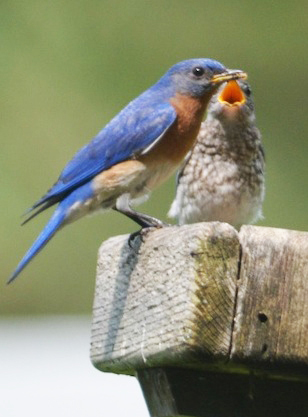State bird is soaring back
Fredonia couple helps educate, play role in major return

By WILLIAM MOHAN
editorial@observertoday.com
“The bluebird carries the sky on his back.”
These were the words written in the personal journal of poet Henry David Thoreau as he described the bluebird in May 1852. The Eastern Bluebird is also the state bird of New York and prominent in the eastern United States.
Even though the bluebird has been used as a subject of art, poetry and similar works, their population in numbers has not always been a sturdy one. From the early to mid 1900s, the species experienced a severe decline as a result of a shortage of nesting locations. In the case of bluebirds, that was their habitat of dead trees, fence posts and similar locations. In addition, the species also was competing for nesting locations from non-native species such as house sparrows and starlings and was affected by pesticide use.

As a result, their numbers had severely declined by the 1950s and 1960s. In 1982, the New York State Bluebird Society was founded. Today, their numbers have grown substantially with a 70% increase between 2000 and 2005, according to the organization’s website.
One Fredonia couple has been maintaining bluebird habitats and promoting the species for 27 years.
John and Bev Ruska have been watching, attracting and maintaining various bird species on their Fredonia farm since retiring from their teaching and counseling positions at the State University at Fredonia and the Dunkirk School system. While they enjoy bird watching, the species they enjoy watching the most is the bluebird.
But while they are currently active members of the New York State Blue Bird Society, their involvement with bluebirds began two decades before their retirement.
Both had equally been interested in nature growing up in Erie, Pa. Bev Ruska remembers being interested in birds through her time with her local Junior Audubon Society.

John Ruska gives a presentation at the Jamestown Audubon Nature Center in June. Above is a bluebird on a house while at the bottom left is a bluebird and fledgling on wood.
“I would get pamphlets, color photos, etc. and I used to draw them. I made numerous drawings as a child,” Bev Ruska said. “That got me going and it took me years before I even saw some of these birds. I didn’t see a lot of the birds I drew until I was an adult.”
Today, Bev Ruska describes herself as an avid bird watcher who can quickly point out differences in species, gender and other characteristics.
“I spend more time observing,” she said.
In 1972, Bev Ruska was teaching an art class at SUNY Fredonia. The project that day was focused on nature. Initially, she posed the idea to her class that they had never seen the bluebird because of their then small population.
“She told the class you have never seen the Eastern Blue Bird it’s the state bird, and one student said, ‘Yes I have,’ ” John Ruska said.
The student then told Bev Ruska about her farm on Whitaker Road in Fredonia. There the student’s family showed her where the birds where nesting and how they were living on the property.
It was during this time that Bev Ruska showed the location to her husband. From there, his love of bluebirds began.
Unknowingly, the property would play an important role in the Ruskas’ retirement.
Twenty years later in 1992, two events took place that would further instill the couple’s involvement with preservation of the bluebird. The first took place out of state in the Bentson-Rio Grande River State Park in Mission, Texas, during a birdwalk tour the couple took.
- John Ruska gives a presentation at the Jamestown Audubon Nature Center in June. Above is a bluebird on a house while at the bottom left is a bluebird and fledgling on wood.








